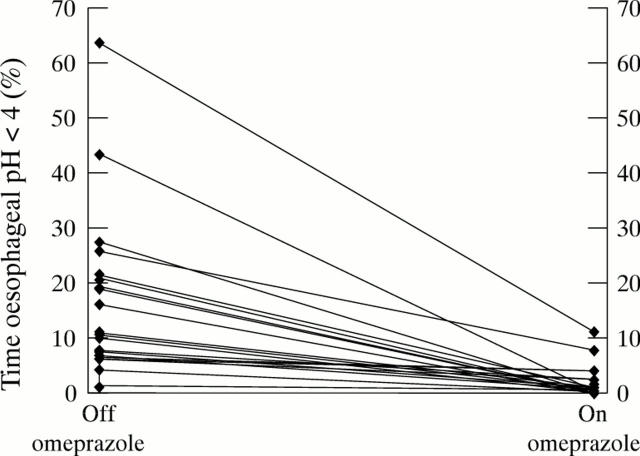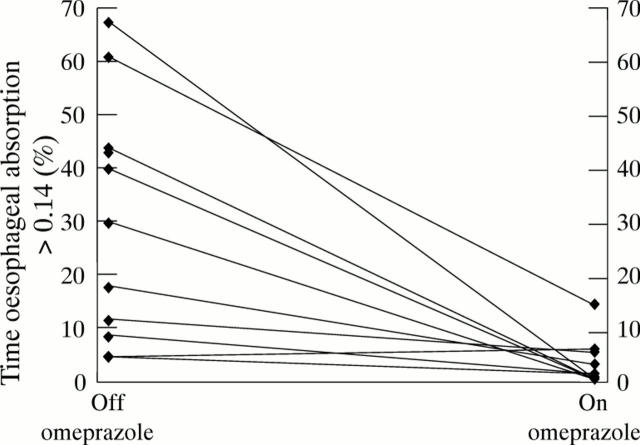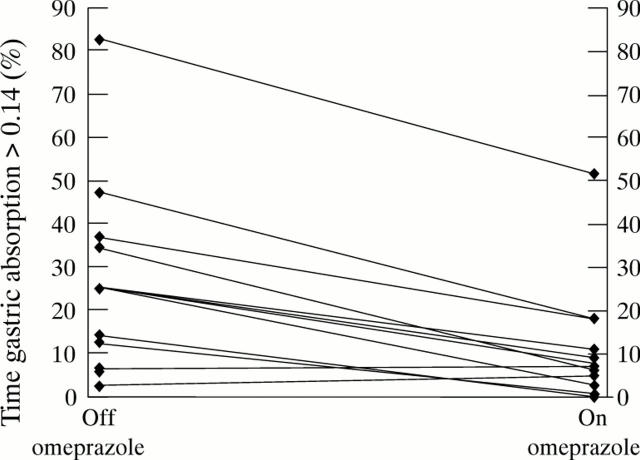Abstract
Background—Both acid and duodenal contents are thought to be responsible for the mucosal damage in Barrett's oesophagus, a condition often treated medically. However, little is known about the effect of omeprazole on duodenogastric reflux (DGR) and duodenogastro-oesophageal reflux (DGOR). Aims—To study the effect of omeprazole 20 mg twice daily on DGR and DGOR, using the technique of ambulatory bilirubin monitoring. Methods—Twenty three patients with Barrett's oesophagus underwent manometry followed by 24 hour oesophageal and gastric pH monitoring. In conjunction with pH monitoring, 11 patients (group 1) underwent oesophageal bilirubin monitoring and 12 patients (group 2) underwent gastric bilirubin monitoring, both before and during treatment with omeprazole 20 mg twice daily. Results—In both groups there was a significant reduction in oesophageal acid (pH<4) reflux (p<0.005) and a significant increase in the time gastric pH was above 4 (p<0.005). In group 1, median total oesophageal bilirubin exposure was significantly reduced from 28.9% to 2.4% (p<0.005). In group 2, median total gastric bilirubin exposure was significantly reduced from 24.9% to 7.2% (p<0.005). Conclusions—Treatment of Barrett's oesophagus with omeprazole 20 mg twice daily results in a notable reduction in the exposure of the oesophagus to both acid and duodenal contents. In addition, delivery of duodenal contents to the upper gastric body is reduced.
Keywords: bilirubin monitoring; Barrett's oesophagus; omeprazole; pH monitoring; duodenogastric reflux; duodenogastro-oesophageal reflux
Full Text
The Full Text of this article is available as a PDF (103.9 KB).
Figure 1 .
Group 1 and 2 patients combined: individual oesophageal acid reflux times before and during omeprazole treatment.
Figure 2 .
Group 1: individual oesophageal bilirubin reflux times before and during omeprazole treatment.
Figure 3 .
Group 2: individual gastric bilirubin reflux times before and during omeprazole treatment.
Selected References
These references are in PubMed. This may not be the complete list of references from this article.
- Attwood S. E., Ball C. S., Barlow A. P., Jenkinson L., Norris T. L., Watson A. Role of intragastric and intraoesophageal alkalinisation in the genesis of complications in Barrett's columnar lined lower oesophagus. Gut. 1993 Jan;34(1):11–15. doi: 10.1136/gut.34.1.11. [DOI] [PMC free article] [PubMed] [Google Scholar]
- Bechi P., Pucciani F., Baldini F., Cosi F., Falciai R., Mazzanti R., Castagnoli A., Passeri A., Boscherini S. Long-term ambulatory enterogastric reflux monitoring. Validation of a new fiberoptic technique. Dig Dis Sci. 1993 Jul;38(7):1297–1306. doi: 10.1007/BF01296082. [DOI] [PubMed] [Google Scholar]
- Benini L., Castellani G., Bardelli E., Sembenini C., Brentegani M. T., Caliari S., Vantini I. Omeprazole causes delay in gastric emptying of digestible meals. Dig Dis Sci. 1996 Mar;41(3):469–474. doi: 10.1007/BF02282320. [DOI] [PubMed] [Google Scholar]
- Bremner C. G., Lynch V. P., Ellis F. H., Jr Barrett's esophagus: congenital or acquired? An experimental study of esophageal mucosal regeneration in the dog. Surgery. 1970 Jul;68(1):209–216. [PubMed] [Google Scholar]
- Caldwell M. T., Byrne P. J., Brazil N., Crowley V., Attwood S. E., Walsh T. N., Hennessy T. P. An ambulatory bile reflux monitoring system: an in vitro appraisal. Physiol Meas. 1994 Feb;15(1):57–65. doi: 10.1088/0967-3334/15/1/005. [DOI] [PubMed] [Google Scholar]
- Champion G., Richter J. E., Vaezi M. F., Singh S., Alexander R. Duodenogastroesophageal reflux: relationship to pH and importance in Barrett's esophagus. Gastroenterology. 1994 Sep;107(3):747–754. doi: 10.1016/0016-5085(94)90123-6. [DOI] [PubMed] [Google Scholar]
- Clark G. W., Smyrk T. C., Mirvish S. S., Anselmino M., Yamashita Y., Hinder R. A., DeMeester T. R., Birt D. F. Effect of gastroduodenal juice and dietary fat on the development of Barrett's esophagus and esophageal neoplasia: an experimental rat model. Ann Surg Oncol. 1994 May;1(3):252–261. doi: 10.1007/BF02303531. [DOI] [PubMed] [Google Scholar]
- Festen H. P., Tuynman H. A., Défize J., Pals G., Frants R. R., Straub J. P., Meuwissen S. G. Effect of single and repeated doses of oral omeprazole on gastric acid and pepsin secretion and fasting serum gastrin and serum pepsinogen I levels. Dig Dis Sci. 1986 Jun;31(6):561–566. doi: 10.1007/BF01318685. [DOI] [PubMed] [Google Scholar]
- Gillen P., Keeling P., Byrne P. J., West A. B., Hennessy T. P. Experimental columnar metaplasia in the canine oesophagus. Br J Surg. 1988 Feb;75(2):113–115. doi: 10.1002/bjs.1800750208. [DOI] [PubMed] [Google Scholar]
- Hamilton S. G., Sheiner H. J., Quinlan M. F. Continuous monitoring of the effect of pentagastrin on gastric emptying of solid food in man. Gut. 1976 Apr;17(4):273–279. doi: 10.1136/gut.17.4.273. [DOI] [PMC free article] [PubMed] [Google Scholar]
- Horowitz M., Hetzel D. J., Buckle P. J., Chatterton B. E., Shearman D. J. The effect of omeprazole on gastric emptying in patients with duodenal ulcer disease. Br J Clin Pharmacol. 1984 Nov;18(5):791–794. doi: 10.1111/j.1365-2125.1984.tb02544.x. [DOI] [PMC free article] [PubMed] [Google Scholar]
- Hunt J. N., Ramsbottom N. Effect of gastrin II on gastric emptying and secretion during a test meal. Br Med J. 1967 Nov 18;4(5576):386–387. doi: 10.1136/bmj.4.5576.386. [DOI] [PMC free article] [PubMed] [Google Scholar]
- Johnson L. F., Demeester T. R. Twenty-four-hour pH monitoring of the distal esophagus. A quantitative measure of gastroesophageal reflux. Am J Gastroenterol. 1974 Oct;62(4):325–332. [PubMed] [Google Scholar]
- Katzka D. A., Castell D. O. Successful elimination of reflux symptoms does not insure adequate control of acid reflux in patients with Barrett's esophagus. Am J Gastroenterol. 1994 Jul;89(7):989–991. [PubMed] [Google Scholar]
- Kauer W. K., Burdiles P., Ireland A. P., Clark G. W., Peters J. H., Bremner C. G., DeMeester T. R. Does duodenal juice reflux into the esophagus of patients with complicated GERD? Evaluation of a fiberoptic sensor for bilirubin. Am J Surg. 1995 Jan;169(1):98–104. doi: 10.1016/s0002-9610(99)80116-0. [DOI] [PubMed] [Google Scholar]
- Lamberts R., Creutzfeldt W., Strüber H. G., Brunner G., Solcia E. Long-term omeprazole therapy in peptic ulcer disease: gastrin, endocrine cell growth, and gastritis. Gastroenterology. 1993 May;104(5):1356–1370. doi: 10.1016/0016-5085(93)90344-c. [DOI] [PubMed] [Google Scholar]
- Leite L. P., Johnston B. T., Just R. J., Castell D. O. Persistent acid secretion during omeprazole therapy: a study of gastric acid profiles in patients demonstrating failure of omeprazole therapy. Am J Gastroenterol. 1996 Aug;91(8):1527–1531. [PubMed] [Google Scholar]
- Lind T., Cederberg C., Ekenved G., Haglund U., Olbe L. Effect of omeprazole--a gastric proton pump inhibitor--on pentagastrin stimulated acid secretion in man. Gut. 1983 Apr;24(4):270–276. doi: 10.1136/gut.24.4.270. [DOI] [PMC free article] [PubMed] [Google Scholar]
- Mattioli S., Felice V., Pilotti V., Bacchi M. L., Pàstina M., Gozzetti G. Indications for 24-hour gastric pH monitoring with single and multiple probes in clinical research and practice. Dig Dis Sci. 1992 Dec;37(12):1793–1801. doi: 10.1007/BF01308070. [DOI] [PubMed] [Google Scholar]
- Oberg S., Peters J. H., DeMeester T. R., Chandrasoma P., Hagen J. A., Ireland A. P., Ritter M. P., Mason R. J., Crookes P., Bremner C. G. Inflammation and specialized intestinal metaplasia of cardiac mucosa is a manifestation of gastroesophageal reflux disease. Ann Surg. 1997 Oct;226(4):522–532. doi: 10.1097/00000658-199710000-00013. [DOI] [PMC free article] [PubMed] [Google Scholar]
- Pedersen S. A., Kraglund K., Vinter-Jensen L. The effects of omeprazole on gastro-oesophageal sphincter pressure, intragastric pH, and the migrating motor complex in fasting healthy subjects. Scand J Gastroenterol. 1987 Aug;22(6):725–730. doi: 10.3109/00365528709011150. [DOI] [PubMed] [Google Scholar]
- Rasmussen L., Oster-Jørgensen E., Qvist N., Hovendal C. P., Kraglund K., Olsen O., Schaffalitzky de Muckadell O. B., Rehfeld J., Pedersen S. A. The effects of omeprazole on interdigestive motility and early postprandial levels of gastrin and secretin. Scand J Gastroenterol. 1992;27(2):119–123. doi: 10.3109/00365529209165430. [DOI] [PubMed] [Google Scholar]
- Rasmussen L., Oster-Jørgensen E., Qvist N., Kraglund K., Hovendal C., Pedersen S. A. Short report: a double-blind placebo-controlled trial of omeprazole on characteristics of gastric emptying in healthy subjects. Aliment Pharmacol Ther. 1991 Feb;5(1):85–89. doi: 10.1111/j.1365-2036.1991.tb00009.x. [DOI] [PubMed] [Google Scholar]
- Vaezi M. F., Lacamera R. G., Richter J. E. Validation studies of Bilitec 2000: an ambulatory duodenogastric reflux monitoring system. Am J Physiol. 1994 Dec;267(6 Pt 1):G1050–G1057. doi: 10.1152/ajpgi.1994.267.6.G1050. [DOI] [PubMed] [Google Scholar]
- Vaezi M. F., Richter J. E. Synergism of acid and duodenogastroesophageal reflux in complicated Barrett's esophagus. Surgery. 1995 Jun;117(6):699–704. doi: 10.1016/s0039-6060(95)80015-8. [DOI] [PubMed] [Google Scholar]
- Verdú E. F., Fraser R., Murphy G. M., Blum A. L., Armstrong D. The origin of nocturnal intragastric pH rises in healthy subjects. Scand J Gastroenterol. 1995 Oct;30(10):935–943. doi: 10.3109/00365529509096335. [DOI] [PubMed] [Google Scholar]
- Vinter-Jensen L., Kraglund K., Pedersen S. A. A double-blind placebo-controlled trial of omeprazole on characteristics of the migrating motor complex in healthy volunteers. Aliment Pharmacol Ther. 1989 Dec;3(6):615–620. doi: 10.1111/j.1365-2036.1989.tb00255.x. [DOI] [PubMed] [Google Scholar]
- Wetscher G. J., Hinder R. A., Kretchmar D., Stinson R., Perdikis G., Smyrk T., Klingler P. J., Adrian T. E. Duodenogastric reflux causes growth stimulation of foregut mucosa potentiated by gastric acid blockade. Dig Dis Sci. 1996 Nov;41(11):2166–2173. doi: 10.1007/BF02071396. [DOI] [PubMed] [Google Scholar]





